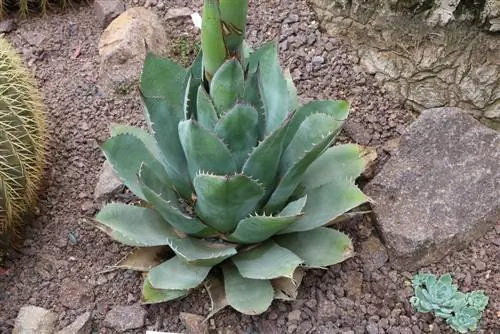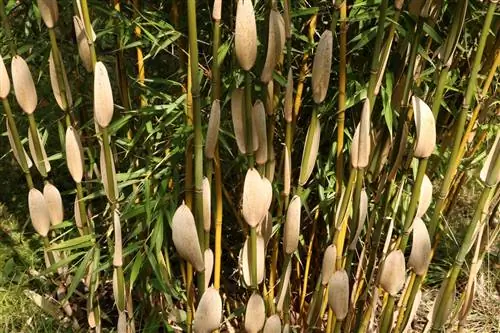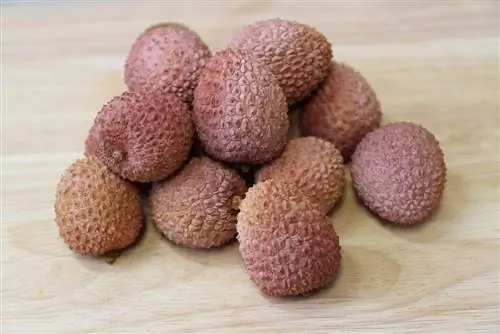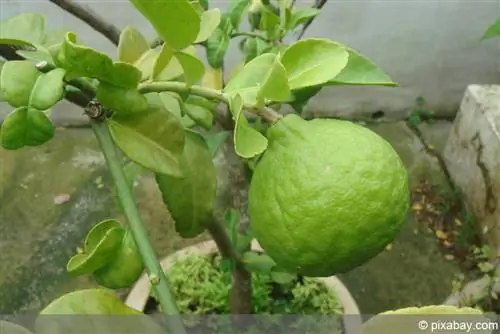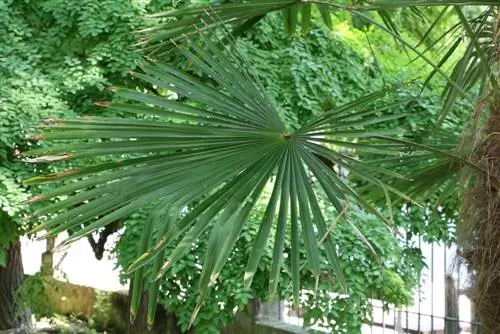- Author admin [email protected].
- Public 2023-12-17 03:39.
- Last modified 2025-01-24 12:45.
Most agave varieties are not hardy. However, individual varieties are used to low temperatures because they grow outdoors in mountains. If you have such plants, you can leave them outside in a protected location even in winter. In this country, however, agaves are mostly used as potted plants precisely because they can withstand a maximum of temperatures between 10 and 15 °C. So for overwintering you need a suitable parking space in the house, in the garage or in the greenhouse.
Making it pleasant to a desert plant
Plants of the genus Agave come from Mexico and South America. They were later introduced to the Mediterranean. You can now see their mighty rosettes in many gardens there. In our latitudes, agaves feel most comfortable on warm summer days and need a place to overwinter from autumn onwards. In nature, the agave has to use thorns to protect itself from predators who want to access the water supplies in its leaves. Although water is very rare in the agave's native habitats, the plants can live up to a hundred years. However, they only bloom once in their entire life, even if they have an easier life with a Central European gardener than in the Mexican desert. There are different ways of propagating agaves. Firstly, the flowers can be pollinated by insects, hummingbirds or nectar-eating bats, after which the seeds are dispersed by the wind. On the other hand, small leaf rosettes, so-called children, are formed that grow out to the side of the large rosette. In nature, in such a case, the withered mother plant dies and the child grows in the same place. In pot culture, however, the mother plant can be saved by removing the child in a timely manner.
Temperature and location
As an exotic plant, the agave is popular as a pot or container plant in Central Europe. This means that your children can easily be cultivated in their own pot after being separated. Agaves cannot be planted in this country because they would not survive the winter. As far as the plants' requirements are concerned, your bedroom would in principle be a suitable place to overwinter as it is bright, dry and relatively cool. Please note:
- put away the containers with the agaves in good time
- definitely act before the first frosts
- best at under 7 ?C
- If possible, place the pots in autumn so that the soil does not get wet when it rains
The right location for overwintering agaves should be bright and cool, with temperatures between 10 and 15 °C being best. The following are therefore suitable:
- bright staircases,
- heatable greenhouses,
- Garages with windows,
- bright, unheated attics
Only in an emergency should an agave be overwintered in a warm, heated room. If the agave is indoors, you should pad the hard tips of the leaves to be on the safe side. To do this, simply place wine corks on the ends of the leaves.
The necessary light and irrigation
Typical care mistakes when overwintering agaves are:
- too dark rooms
- watering too frequently
- Damage caused by pest infestation
The optimal winter storage of the agaves is in cold houses. After all, this genus of plants generally needs little water and in a cold room in winter it needs almost no liquid at all. Watering twice during the entire wintering period is sufficient at temperatures between 10 and 15 °C. At slightly higher temperatures you should water them a little more often. Alternatively, you can also spray the agave lightly on the leaves every now and then. In any case, you should make sure that there is never any water in the saucer. Overall, dry conditions are much better for the agave than wet conditions. If the outside temperatures are above 7°C again, you should put the plant outside again, as it still grows best there. From then on, water and fertilize them more frequently again. At the beginning of spring, the agave initially needs a partially shaded place. Otherwise it can burn from the sun's rays. After a few weeks it can be placed back in a sunny location.
Fertilization and pest control
Before storing the agaves for the winter, it is best to examine the pots and the plants. Cleaning at the same time prevents pests from being introduced. During the overwintering period of the agave, you need to pay more attention to pest infestations. Therefore, check regularly for annoying small insects so that you can quickly take appropriate countermeasures in the event of an infestation. If you recognize the parasites early and start fighting them early, you can avoid major damage to your agaves. The use of chemical control agents can often be avoided by reacting early. A controversial topic is the fertilization of agaves. While some experts consider no fertilizer at all necessary, others point out that the natural habitats of agaves are usually dry and have stony, rocky soil. The substrate in the Central European bucket or pot should therefore consist of two parts potting soil and one part quartz sand. If this is not the case, light fertilization may be necessary. In summer, for example, agaves need a complete fertilizer in a weak dosage every two weeks, which is given to them with the irrigation water. No matter the season, the root ball of an agave should always be slightly moist. However, you only need to water when the surface of the soil has dried out.
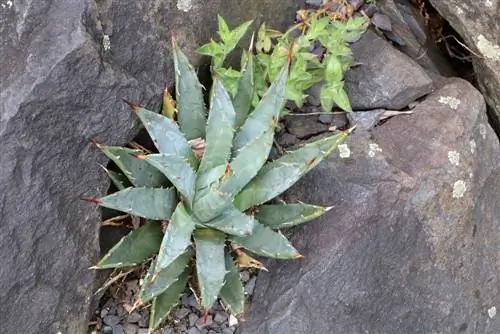
Relatively hardy agave varieties are Agave parryi, Agave neomexicana and Agave schottii. However, most other species belong in a bright and not too warm place from autumn onwards. There they usually don't need to be watered, but they do need to be checked regularly for pests. In spring, you should initially store agaves in a partially shaded place so that they can gradually get used to the light and warmth again.
Overwintering agaves in a cold house
Most agave species can tolerate short-term frost, but if possible they should be put away before the first night frosts in order to overwinter in a frost-free room. The temperature there should be between 5° and 10° C and it should be light. A location in a bright stairwell would therefore be well suited. Agaves often grow in the wild in desert areas and can store water in their leaves. Therefore, they generally need little water and are hardly watered at all in a cold room in winter and only rarely at slightly higher temperatures. Instead of watering them, their leaves can also be lightly sprayed every now and then.
As soon as the outside temperatures allow it again, the agave should be put outside again because it grows best there. From then on you will water more frequently and fertilize again. When transporting, pay attention to the very hard tips of the leaves, which can easily cause injury. To avoid injury, wine corks can be placed on the ends of the leaves. Because of these thorny tips, an agave should not be placed in a place where children play. At the beginning of spring, the agave initially needs a semi-shady place so that it doesn't get burned by the sun's rays, but later it can be moved back to a sunny location.
Relatively hardy agave varieties
In general, agaves are not hardy, but some varieties also grow in mountains and are therefore used to low temperatures. These plants can also spend the winter outside in a protected location.
- The Agave parryi grows in the United States and Mexico at altitudes above 2000 meters and can therefore tolerate temperatures of up to -20° C. It has gray-blue leaves, grows very slowly and is only around 60 centimeters in total high. In order to overwinter them outdoors, it is important to ensure that the place where they are planted does not become waterlogged.
- The Agave neomexicana, which comes from mountainous areas in Texas and Mexico, can tolerate even stronger frost. In a dry location, its frost tolerance is between -20° and -30° C. It has thick bluish leaves and grows to almost a meter high and just as wide.
- The Agave schottii has narrow, dark green leaves with threads. It remains quite small at around 30 centimeters and does not have such piercing leaf tips as other types of agave. It can withstand temperatures down to -12° C.

